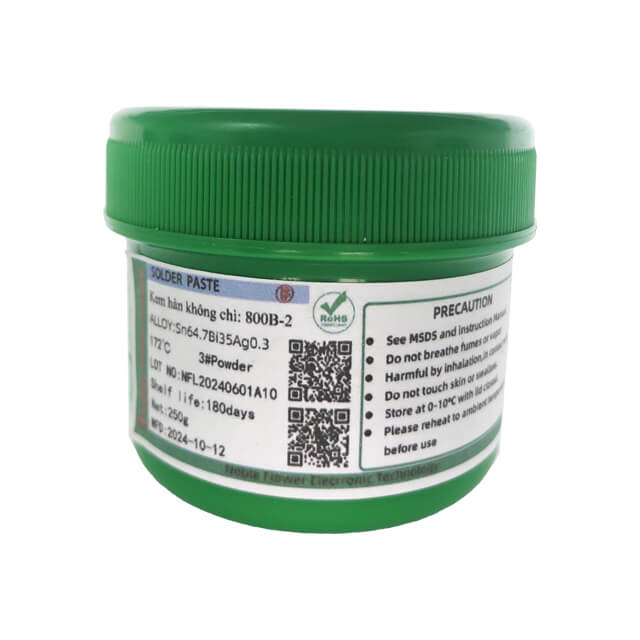意见:1 创始人: Site Editor Publish Time: 2024-11-21 Origin: 网站








In the solder industry, solder paste, as an
indispensable material for reflow soldering, can be divided into lead-free
solder paste and leaded solder paste according to environmental standards. The
lead-free solder paste contains 3.0 silver and 0.3 silver environmentally
friendly high-temperature solder paste, both of which belong to the
silver-containing environmentally friendly lead-free solder paste series
products, and both have passed ROHS certification and are suitable for SMT
reflow soldering process. So what's the difference? Double Chile solder
manufacturers make the following summary: 1. The silver content of the two
types of solder paste is different: 3.0 silver lead-free solder paste is 3%
silver, and 0.3 silver lead-free solder paste is 0.3% silver.
1. The silver content is different: 3.0
silver lead-free solder paste has a silver content of 3%, while 0.3 silver
lead-free solder paste has a silver content of 0.3%. In the solder industry, it
is crucial to understand the difference between lead-free solder paste 3.0
silver and 0.3 silver. In terms of silver content, 3.0 silver lead-free solder
paste contains 3% silver, 0.3 silver lead-free solder paste contains 0.3%
silver, and this difference directly affects their other properties. In terms
of melting point, the 3.0 silver solder paste alloy is Sn96.5Ag3.0Cu0.5, and
the melting point is 210 - 220 degrees; The 0.3 silver solder paste alloy is
Sn99Ag0.3Cu0.7, and the melting point is 217 - 227 degrees, and the operating
temperature is also different due to different melting points. In terms of
performance, 3.0 silver solder paste has better performance in firmness,
fatigue resistance, conductivity, etc., and its comprehensive performance is
perfect and commonly used, and its climbing rate and fullness are also
strengths; 0.3 silver solder paste is inferior to 3.0 silver solder paste in
these properties.
2. Differences in melting points: The
different silver content leads to different alloy structures, and then the
melting point also changes. The alloy of 3.0 silver lead-free solder paste is
Sn96.5Ag3.0Cu0.5, and the melting point is 210 - 220 degrees; The alloy of 0.3
silver lead-free solder paste is Sn99Ag0.3Cu0.7, and the melting point is 217 -
227 degrees. It should be noted that due to the different melting points of 3.0
silver solder paste and 0.3 silver solder paste, there will be certain differences
in the corresponding operating temperatures. 3. Different performance: the most
important performance is firmness, fatigue resistance, conductivity, etc. Among
them, 3.0 silver lead-free solder paste is the most complete solder paste in
various aspects, and it is also the most commonly used lead-free solder paste
temporarily recognized by the international community. The higher its silver
content, the better it will have for various comprehensive properties. At the
same time, the climbing rate and fullness are also the strengths of 3.0
lead-free solder paste.
In the solder industry, it is critical to understand the difference between lead-free solder paste 3.0 silver and 0.3 silver. In terms of silver content, 3.0 silver lead-free solder paste contains 3% silver, 0.3 silver lead-free solder paste contains 0.3% silver, and this difference directly affects other characteristics. In terms of melting point, the 3.0 silver solder paste alloy is Sn96.5Ag3.0Cu0.5, and the melting point is 210 - 220 degrees; The 0.3 silver solder paste alloy is Sn99Ag0.3Cu0.7, and the melting point is 217 - 227 degrees. In terms of performance, 3.0 silver solder paste has better performance in firmness, fatigue resistance, conductivity, etc., and its comprehensive performance is complete and commonly used, and its climbing rate and fullness are also advantages; 0.3 silver solder paste is inferior to 3.0 silver solder paste in these properties. 0.3 silver lead-free solder paste

3. Different performance: mainly reflected
in firmness, fatigue resistance, conductivity and other aspects. Among them,
3.0 silver lead-free solder paste has the most complete properties, and it is
also the most commonly used lead-free solder paste in the world. The higher the
silver content, the better the comprehensive performance. At the same time, the
climbing rate and fullness are also the advantages of 3.0 lead-free solder
paste. Solder soldering
4. Cost difference: the alloy composition
of 3.0 silver and 0.3 silver solder paste is different, in which the silver
content plays an important role, silver is a precious metal, and its
corresponding raw materials are much more expensive, and the price of solder is
also very related to the market situation, so the price of 3.0 silver lead-free
solder paste is much higher than the price of 0.3 silver. In terms of cost,
since silver is a precious metal, 3.0 silver solder paste has a high silver
content and the raw material is more expensive, so the price is much higher
than 0.3 silver solder paste. In terms of the scope of use, 3.0 silver solder
paste is suitable for almost all kinds of component soldering, while 0.3 silver
solder paste can only be used for mid-end soldering of general consumer
electronic products, and the precision soldering effect is not good for
close-foot ICs and 0402 components. In short, understanding these differences
can help you choose the right solder paste based on your product needs and
characteristics, and you should also consider product characteristics, cost and
other factors when purchasing solder paste, and there are a variety of special
solder pastes available on the market, so you can interact with the relevant
manufacturers if you have more questions.